Retreat to the Mountains: A Squamish Story
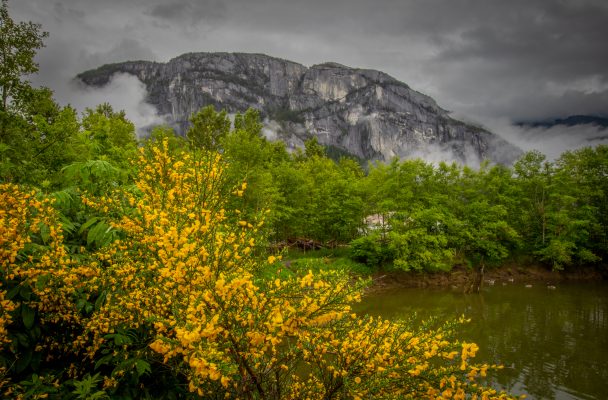
After nearly two and a half years grounded from travel by the pandemic, Robert Brodey boards a plane to an outdoor paradise on Canada’s west coast [June 2022]
The first time I saw it, I was totally mesmerized.
The rock wall appeared in the bus window as I made my way from Vancouver to Whistler, British Columbia, back in 2013. My eyes remained glued to The Stawamus Chief, a towering 700 metre granite dome rising above the rugged Pacific coast and the town of Squamish like a monument to nature’s infinite glory. Only when the road curved inland toward Whistler, the destination of my first official ultra-trail marathon (aptly named Meet your Maker), was my sight torn from that gorgeous monolith. But, at that moment, I knew I would come back one day and take a closer look.
That vision of The Chief stuck with me so much so that I began writing a fictional story set in a place just like Squamish – first as a screenplay then as a novel. The following year, I met Jimmy Martinello, a Squamish resident, alpinist, and overall adventure guy, on an Outpost Magazine trip to Switzerland, and that only solidified my desire to spend time in Squamish.
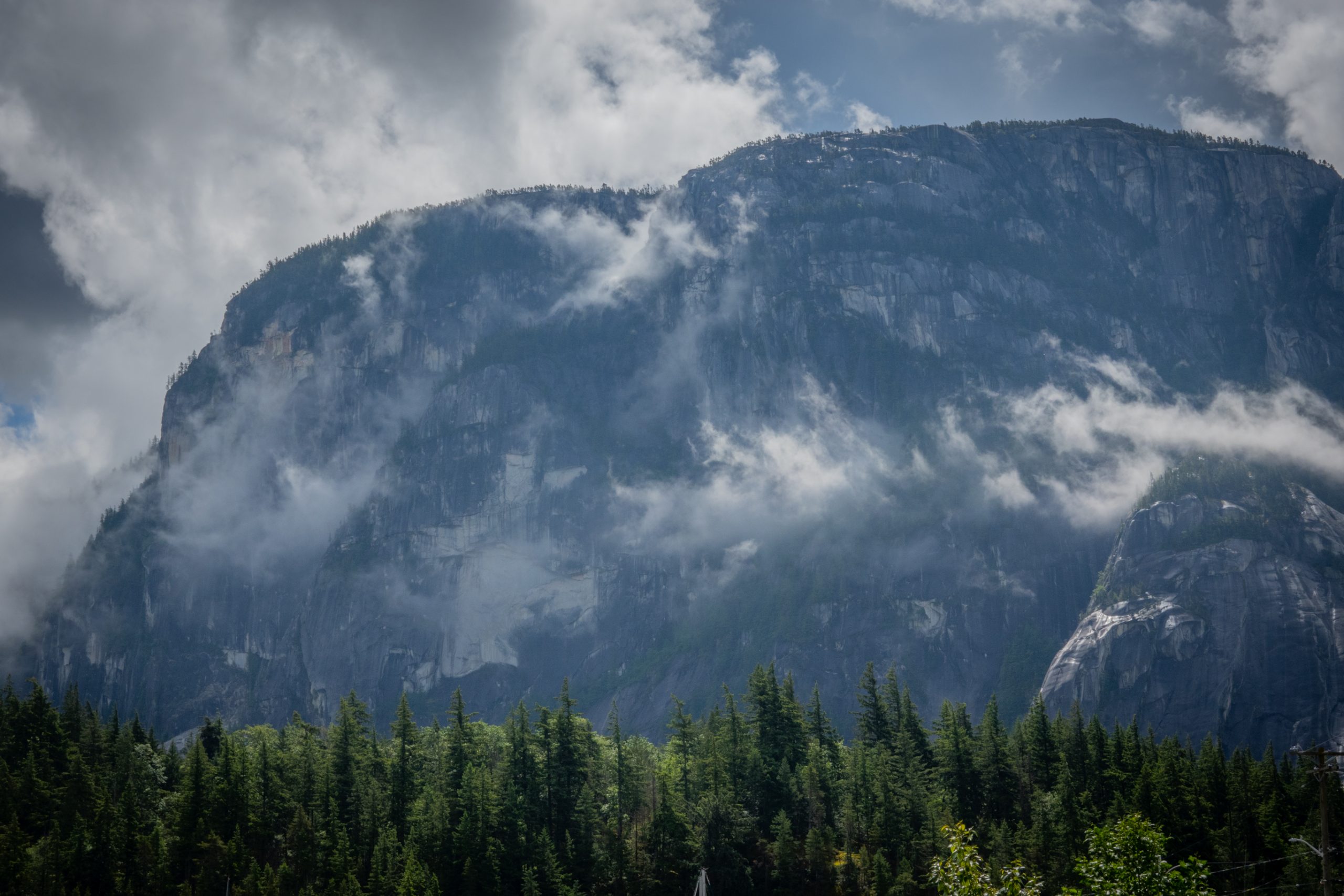 Finally, I booked my flight and made a plan to travel there in the summer of 2020 to do research for my novel and partake in some challenging alpine trail runs, some cycling, and maybe even try my hand at stand-up paddle boarding (a.k.a. SUP boarding). But that flight was cancelled, as the Covid-19 pandemic defied expectation and lasted more than a few inconvenient months. I rebooked the flight for the summer of 2021, because — of course — the pandemic would definitely be over by then.
Finally, I booked my flight and made a plan to travel there in the summer of 2020 to do research for my novel and partake in some challenging alpine trail runs, some cycling, and maybe even try my hand at stand-up paddle boarding (a.k.a. SUP boarding). But that flight was cancelled, as the Covid-19 pandemic defied expectation and lasted more than a few inconvenient months. I rebooked the flight for the summer of 2021, because — of course — the pandemic would definitely be over by then.
Now it’s 2022, and it isn’t until I’ve boarded the plane and fastened my seatbelt that I’m convinced the trip will actually happen. If there’s one thing I’ve learned from the pandemic, it’s that nothing is a given. Everything is subject to change. The upside to this realization: mental flexibility, which envisions future plans not as giant immovable boulders, but more like pretty rocks that are nice to dream about but easy to move on an as-needed basis.
That need for flexibility is tested quickly, as my flight into Vancouver is late, and I miss the last shuttle bus from the airport to Squamish for the day. Time to eat it, Rob, I tell myself. I jump on the Uber app and grab a $134 ride (+ tip!) to Squamish, 80 kilometres up the coast along the insanely picturesque Sea to Sky Highway (Highway 99), with steep verdant mountains on one side and ocean views and islands on the other.
I arrive in Squamish later on a Friday afternoon, the town bustling with weekend visitors. Music blares from various pubs and restaurants along the main strip, Cleveland Avenue, while the sidewalks are filled with young families, patchouli-scented hippies, and lots of older folks, who have come here despite the persistent rainy weather over the last few months.
The weather forecast for the coming week remains bleak for sun-seekers, with rain predicted every day, pretty much all day long– except for one day (Tuesday). Ominously, there are even warnings about an “atmospheric river” that could bring devastating flooding with its warm moist air carried over the Pacific Ocean from Asia. At issue is the unusual amount of snowpack still left at higher elevations among the various mountain ranges of British Columbia. If they melt too quickly, the inundation lower down could be quite hazardous.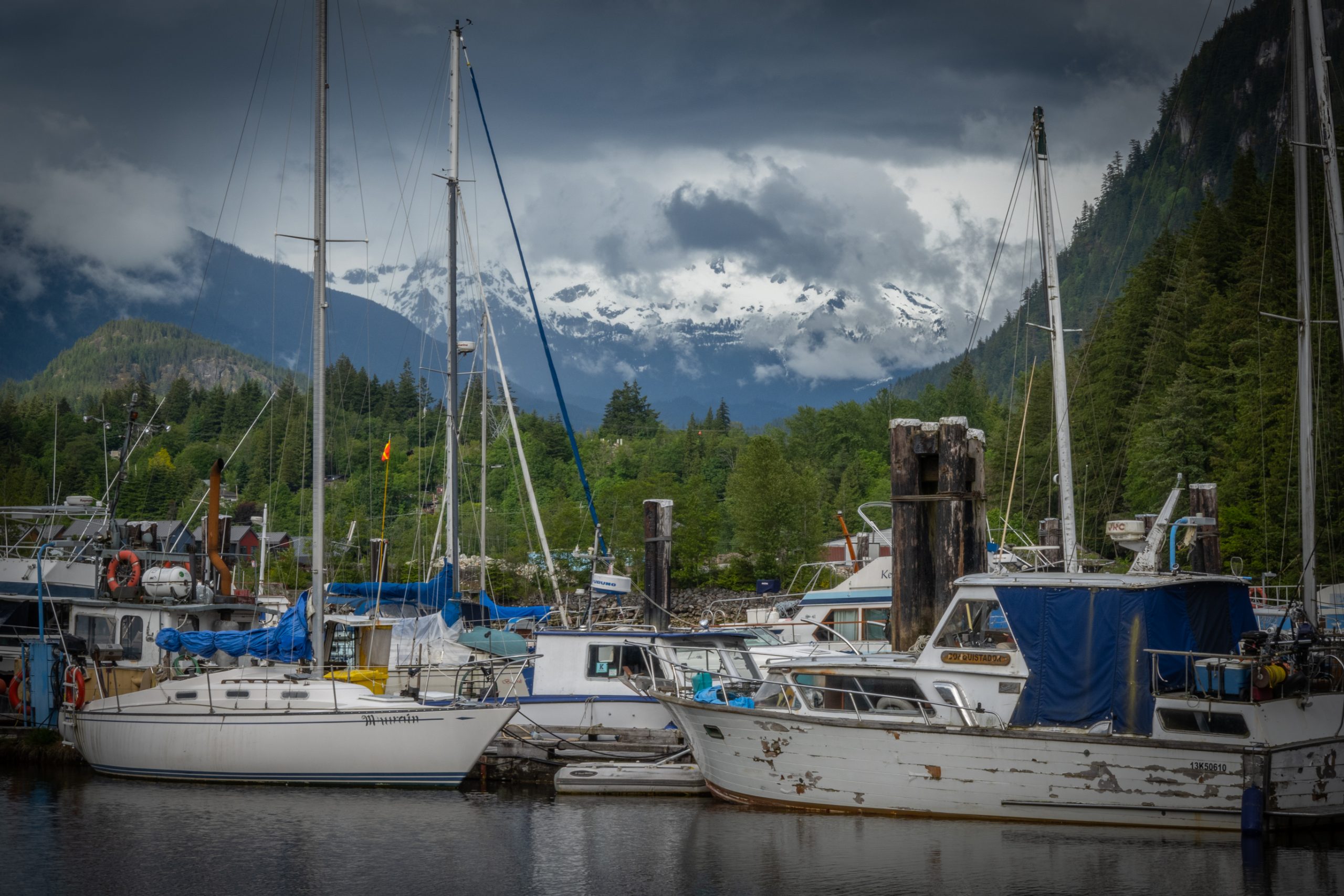
The town itself sits at the top of Howe Sound and is surrounded by an estuary, where the Squamish River and Stawamus River meet the ocean. I am in awe of the landscape, with The Chief’s iconic cliffs to the east of me (The Chief is actually the second largest granite monolith in the world) and the rounded snow-covered summits of the Tantalus Range to the west just beyond the ever-flowing Squamish River. Gazing north is the sturdy base of Mt. Garibaldi (2,678m), its top half shrouded in heavy clouds. It’s a feast for my mountain soul.
I down a pizza and a big green salad at the Howe Sound Inn & Brewing, where I’m staying (how convenient, right?). Then it’s time to walk along some of the nearby estuary trails before I retire for the night. The town may be hopping on the weekend, but it’s still easy to find quiet spaces, which is what I crave. During my 9-day stay, I’m hoping to begin healing from the stress of the last two years of the pandemic, which obliterated the work-life balance and kept me feeling pressurized by circumstances I had little control over.
*
Despite the call for rain on Saturday by Environment Canada, there appears to be no imminent downpour. I head down the main street with its long rows of independent shops selling everything from vintage clothes and artisanal chocolate to tattoos and toys. Just beyond these quaint low-rise storefronts, however, Squamish is experiencing a growth spirt, with townhouses and condos being built at great speed. A quick check at a local real estate office paints a more complete picture of the boom: some two-bedroom condos are now selling for $1.5 million.
I peruse the stalls of a weekend market, which has popped up in a parking lot. I grab a fresh almond croissant, some handmade peanut butter (with ginger!), and some granola then make my way to Zephyr Café, which serves up an espresso comparable to the best I’ve ever had in Toronto (Fox & Oak on Cleveland Avenue also serves up a consistently excellent espresso along with epic-looking specialty donuts).
In fact, what quickly becomes apparent as I wander Squamish is how many great coffee shops and restaurants there are. It’s all on offer: vegan, pub grub, Middle Eastern food, as well as Indian, Vietnamese, and Japanese dining options.
The town has come a long way from its century old roots, as a hub for the forestry, mining, shipping, and railway industry. It now appears to be re-inventing itself, with tourism playing heavily into its next chapter. By the way, there are several museums dedicated to these early industries, including the nearby Britannia Mine Museum and the Railway Museum of British Columbia.
But before I continue any further, let’s do a proper land acknowledgement right here and now. For thousands of years, the indigenous Squamish people (Sḵwx̱wúʔmesh) have called this land home, a territory that once stretched from Vancouver to Howe Sound and inland to Whistler (overlapping with other indigenous groups, as well). Presently, there are approximately four thousand band members registered to the Squamish Nation, with much of the population living among dozens of reserves.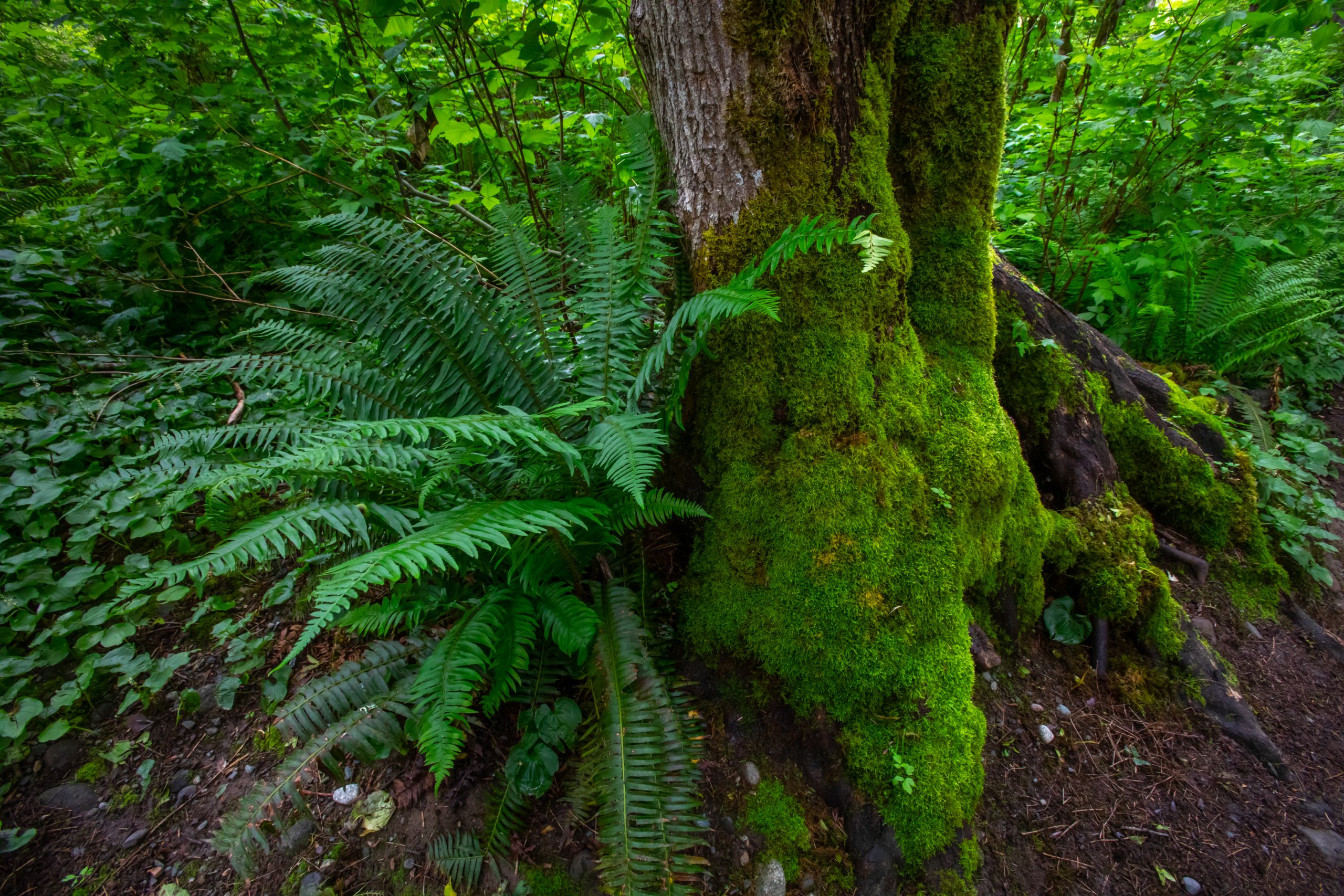
For millennia, Squamish culture, history, and land knowledge was transmitted through the generations orally. And, let’s be clear, oral history isn’t the poor cousin of written history. The level of detail sometimes captured in the intergenerational stories is quite fascinating, whether retelling of the smallpox epidemic in the 1770s that killed off an estimated 30% of the indigenous northwest coast population or an ancient earthquake and tsunami, which came in the night and stole people while they slept. No wonder, those with the greatest knowledge of indigenous cosmology and customs were regarded as aristocrats among the Squamish (material wealth and generosity also played a role in one’s social station).
I take the day to hike along some amazing trails that meander through open marsh and forested tracts of the estuary, but I also partake in lots of down time to read, nap, and draft notes for my novel. In many ways, this is a very unusual trip for me. There is no big push to run, climb, or bike. That’s because a lot has changed recently.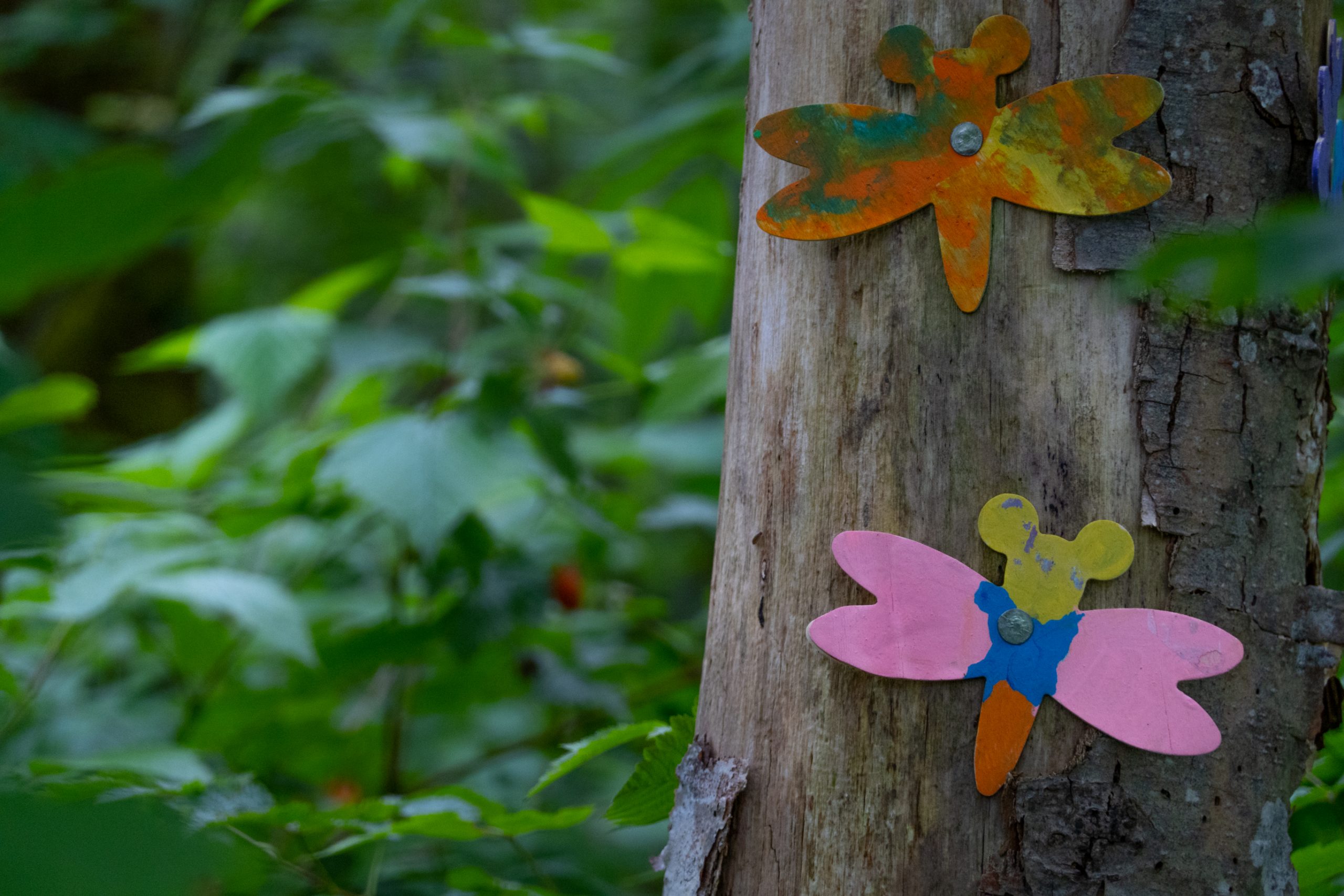
In preparation for this trip, I had begun training through the winter months with lots of runs and indoor biking. Then in February I broke my hand (don’t ask), which forced me to cut back on my workouts, lest I complicate my recovery. Despite the setback, I was coming into Spring feeling optimistic that the pandemic was coming to an end, my hand was healing, and good health was just around the corner.
Then, in April, my son got sick with Covid. I took care of him until I, too, was felled by it a few days later. Getting the omicron variant while triple vaxxed sucked, but it wasn’t the end of the world. However, my lingering chest tightness made me anxious. I couldn’t just ramp up my running mileage. I had to consider that my heart and lungs needed healing time. So the half-marathon trail race I had registered for in May was likely off the table. It just wasn’t worth over-stressing my body.
But the reality was more grim than I realized. Running 4 kilometres suddenly became a huge effort and totally unenjoyable (like “hitting the wall” in a marathon). And I could only run a couple of times a week, because I needed to rest in between. Sometimes the fatigue was so debilitating that I didn’t have the energy to work a full day. It was a terrible affliction, and yet, I am strangely grateful to experience it. It has made me more empathetic to others who suffer from “invisible ailments” that some say are “just in their head.”
Knowing that I couldn’t predict where my health would be for this trip, I decided to break from a more recent pattern established on previous adventure trips – that basically every day was planned out. This time I wanted my health, the weather, and inspiration in the moment to lead the trip, which is really how I had started travelling decades ago: a plane ticket, guidebook, some money, and not much of a plan.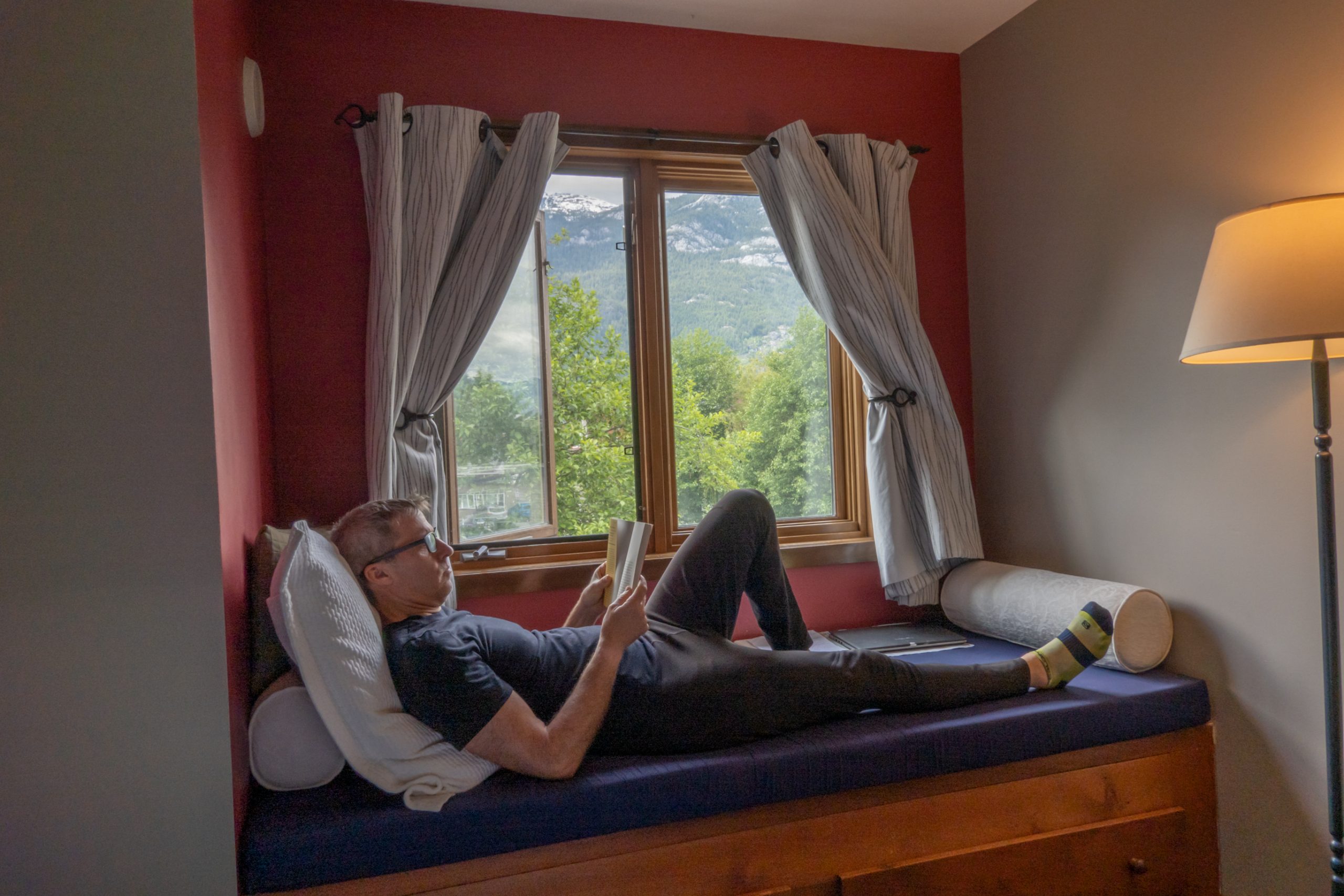
The one goal that remains intact is to hike all three summits of the Chief, if a large enough weather window appears. On paper, the hike doesn’t sound too intimidating, with each summit ranging in height from 610 metres (First Peak) to 702 metres (Third Peak). The summits are separated by deep gullies, which have become popular with Slackliners, who regularly set up high lines dozens of meters across the gullies and tight-rope walk over the abyss on the narrow strap of nylon – sometimes without safety.
*
On Monday morning, with thick clouds marching across the sky, I get a call from my old Outpost Magazine buddy, Jimmy Martinello, who wants to go for a walk in the park with his dog. But this isn’t any old walk in the park. We drive out along a dirt road behind Squamish and park his truck by the side of the road, just as the sun breaks through the clouds. Together, we walk down through the coastal temperate rain forest, which is deep green and mossy and feels like a scene from a Jurassic period diorama. When we arrive at the Mamquam River, Jimmy explains that the area is used as a put-in spot for kayaks and SUP boards to go down river, where the Mamquam meets the Squamish River. “I can ride my SUP board from here all the way back to your hotel,” Jimmy tells me, which reminds me of the critical importance of river transport for so many indigenous groups across Canada through the millennia.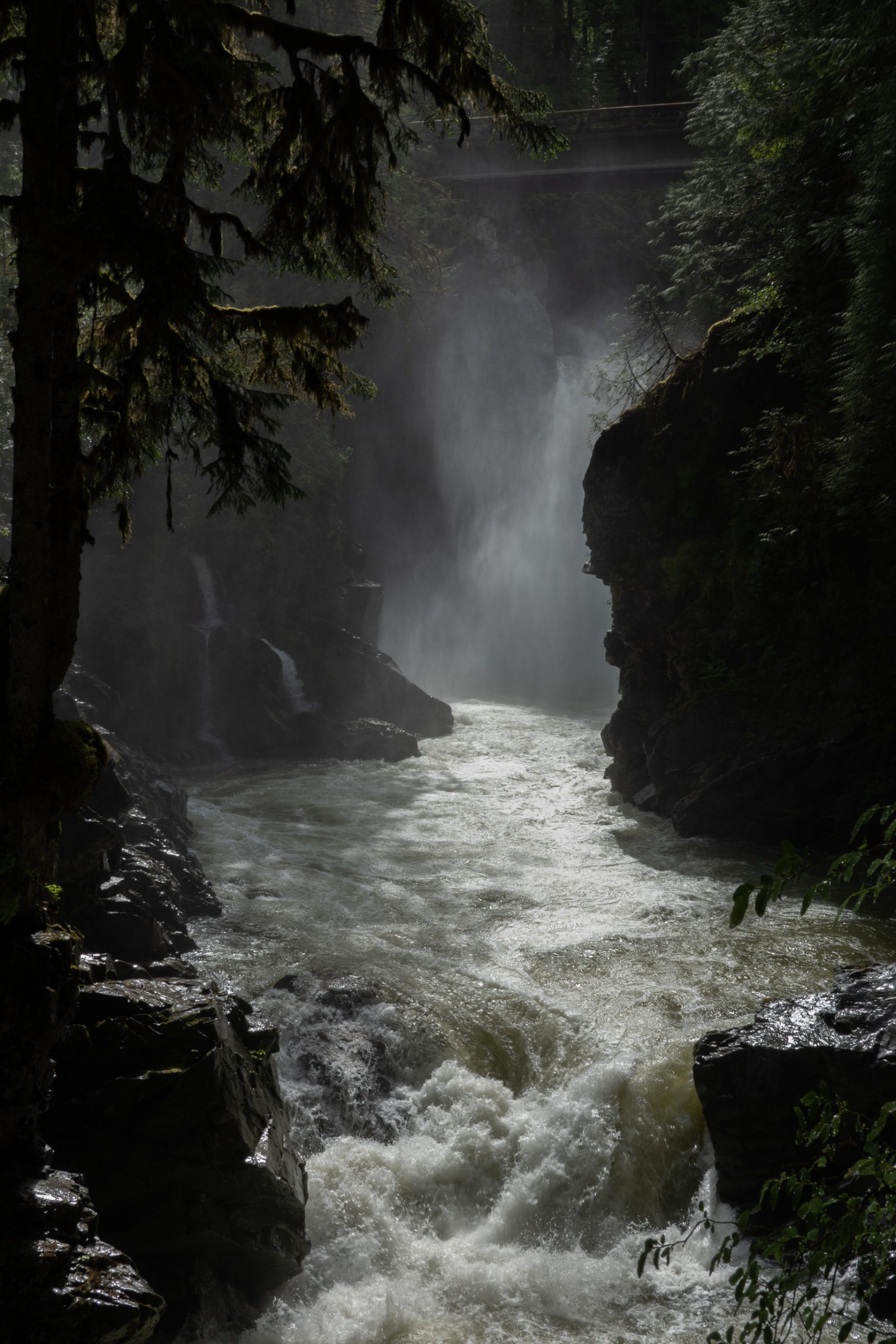
Over the next hour or so, we walk and talk, catching up on family life and the adventures we’ve had since last seeing each other 7 years ago in the Swiss Alps. He brings me to the thundering Mamquam Falls and points out where he has set several sport climbing routes to the left and right of the voluminous falls. Jimmy also recounts his near-death experience in an avalanche a few years back, when he and a friend were swept off a 50 foot cliff and tomahawked down a steep slope for 2000 feet, which left them partially buried – but alive. That experience helped Jimmy re-assess his risk tolerance, especially knowing his wife and two children were waiting for him at home. Lately, he has been dialing into surfing, freediving, and plenty of sports climbing, while working on the foundational practice of conscious breathing.
But perhaps the thing that strikes me most from our conversation is that Jimmy doesn’t have a mobile phone. He has a computer and home phone, but when he goes outside, he is out of reach. He has also opted out of the social media game, so there is no chasing clicks or likes or curating his life so it looks perfect for his followers. I can only imagine how this must shape the way he experiences the world, perhaps aligning him more thoroughly with the present moment.
After Jimmy and I part ways, I feast on a delicious veggie quiche and an apple tart from Sunflower Bakery on Cleveland Avenue. The sunny weather persists, defying the forecasters, which inspires me to walk and jog the seven kilometres along the estuary trails and through a forest towards the Squamish Spit, a long narrow strip of manmade land that juts out of the estuary, at the mouth of the Squamish River. Over the years, the spit has drawn thousands of kite and wind surfers each year from around the world to ride Howe Sound’s famous winds. 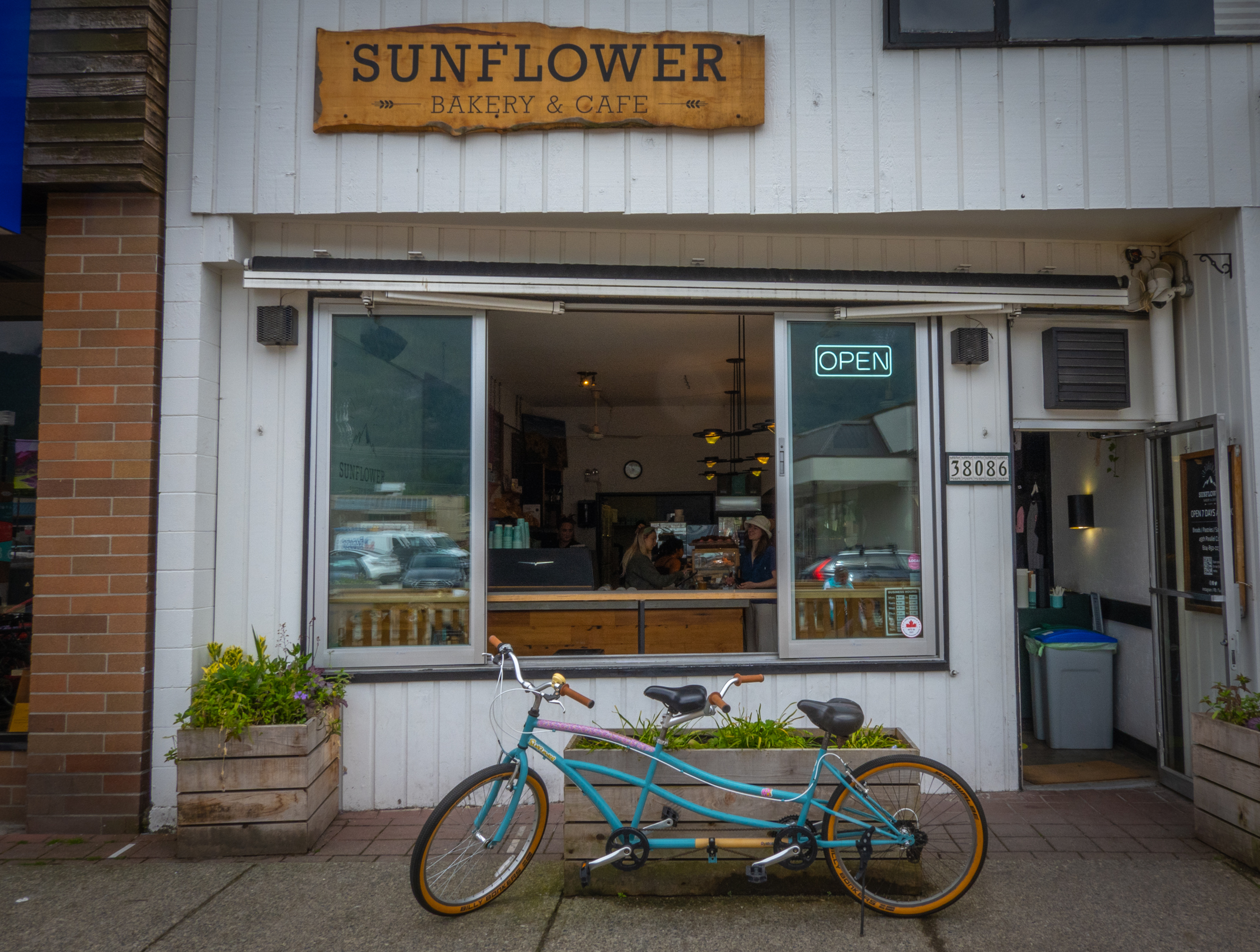
As I jog down the gravel road toward the spit, I feel like I am reconnecting with the spontaneous wanderer in me that had been slumbering since the pandemic roared into our lives. My heart bursts with joy.
Before I know it, Howe Sound comes into view, and I can see several kite surfers skimming across the water, occasionally catching big air as they go. Then the spit comes to an abrupt end, even though my GPS map shows the spit continues on for another half a kilometre or so. I later learn that in a victory for wildlife, particularly the fish, a portion of the berm was removed in early 2022, as it “impedes at-risk juvenile chinook from entering the estuary and funnels them out into the ocean prematurely, causing them to die,” according to conservationists. Young salmon, apparently, need time to acclimate to saltwater, which they can do in the estuary, where the ocean tides meet the river, hence providing a mix of salt and fresh water.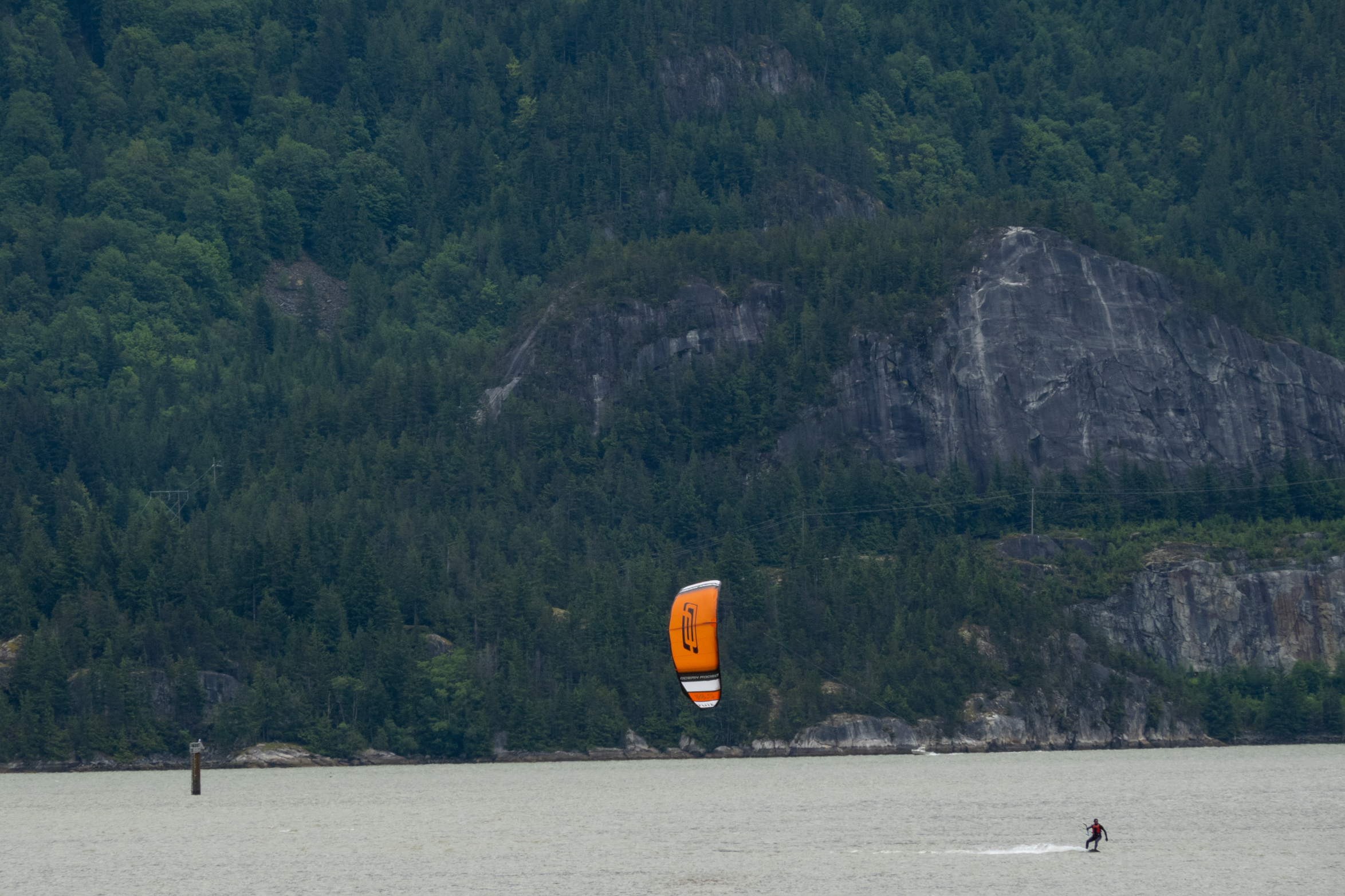
*
It’s 5:30 in the morning on Tuesday when I pull back the curtains of my hotel window. To my relief, there isn’t a cloud in the sky, just as the weather forecast had predicted. With the Stawamus Chief calling to me, I hastily make a cup of coffee (obligatory), wolf down some breakfast, and head out the door.
Looking inland, the summit of Garibaldi crowns Cleveland Avenue like some sort of mountain god sitting at the head of the table. With a little imagination, Garibaldi resembles a rhino, with its rounded back and horned peak. This is, in fact, the first time I’ve glimpsed Garibaldi’s snowy summit since arriving in Squamish last Friday — now that the clouds have finally lifted.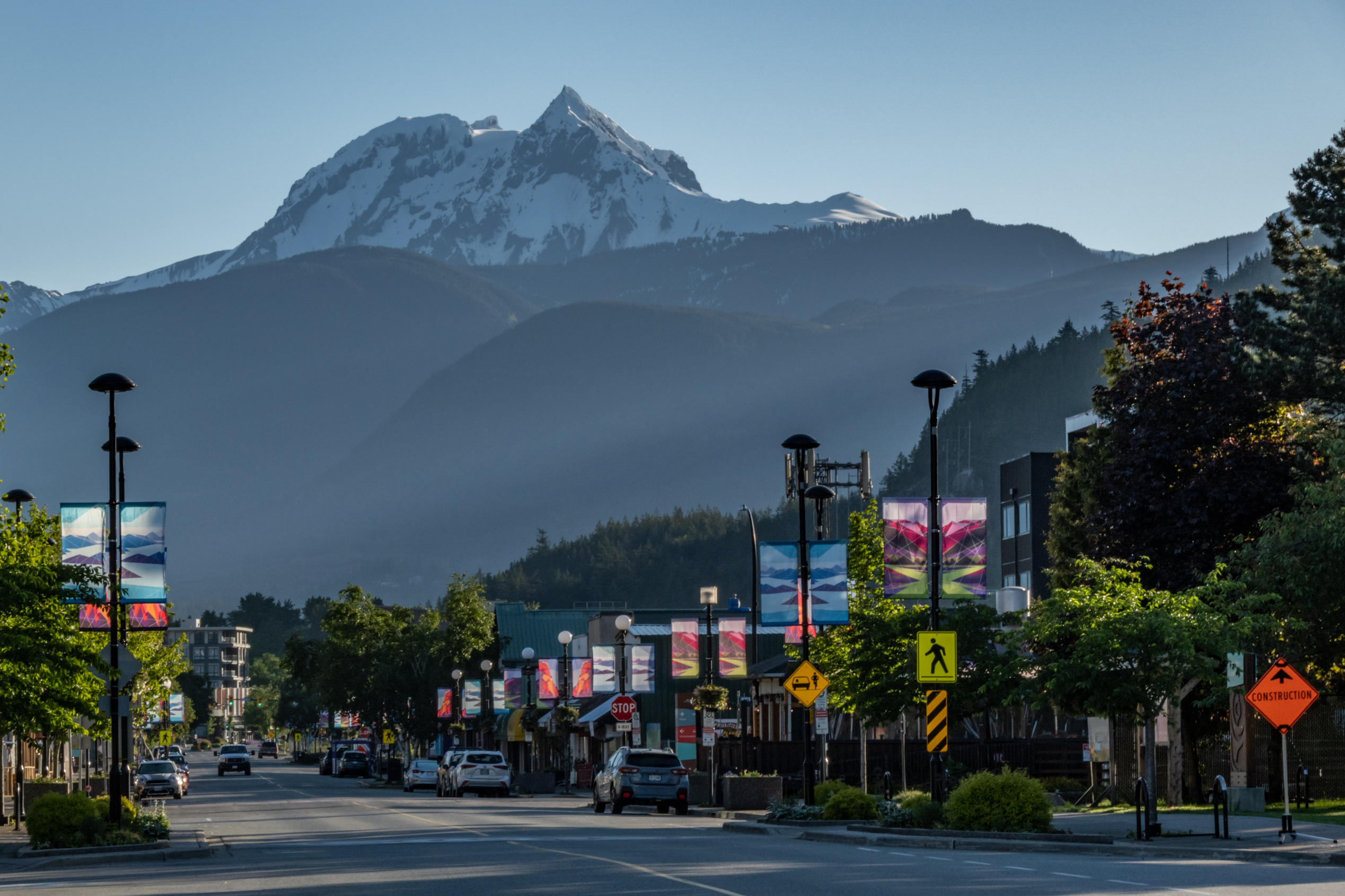
Apparently, about 250,000 years ago, when much of the region was covered in snow and ice, the volcanic Garibaldi thrust its way through the surrounding ice – like a fiery dancer popping out of a cake. The mountain has always been sacred to the Squamish people, with the added bonus that Garibaldi’s volcanic glass (known as obsidian) was great material for making sharp tools (evidence of its use dates back ten thousand years!).
For 3 kilometres or so, I walk along a dedicated bike and pedestrian path that follows the Sea-to-Sky Highway just a few metres away. The aggressive sound of car and truck engines gnaws away at the sense of peace I’ve accumulated over the last few days. But on the upside, the walk provides great views of The Chief and its countless multi-pitch rock-climbing routes, including up the face of “The Apron,” a giant angled slab that juts from the middle of the wall, the Tantalus and Dihedral Walls to the north, and The Grand Wall to the south. Apparently, there are over 1500 rock-climbing routes in and around Squamish and thousands of boulder problems to be tackled for those so inclined (the first ascent of the Grand Wall was accomplished by Ed Cooper and Jim Baldwin back in 1961). 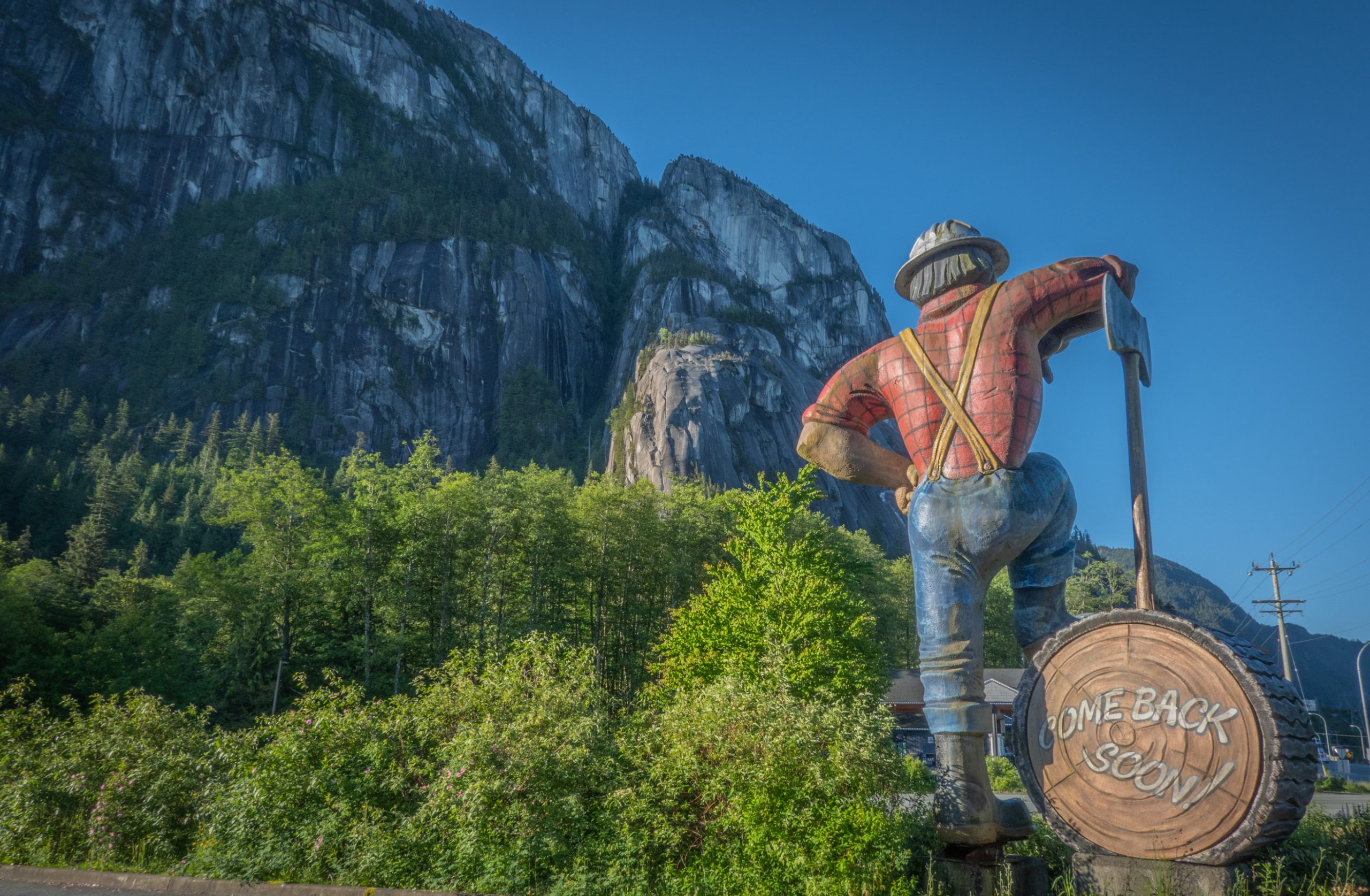
But all these thoughts about rock walls and climbers and their accomplishments fade into the background, after I reach the trailhead just beyond the Grand Wall, and the flat path suddenly angles up hard. The first set of steep wooden stairs starts the leg burn immediately. That verticality, however, doesn’t stop several runners from doing sprint intervals up and down them (perhaps they are training for the famed local ultra-marathon, The Squamish 50 in August).
Despite my fitness envy (it’s a thing), I feel fortunate just to be able to hike with my lungs in their current state, which feel like two tiny balloons filled to burst. I’m here, and that’s what matters to me. Still, as I make my way up the serpentine trail beneath the forest canopy, I keep close watch of my heartrate and any feelings of light-headedness — signs that I could be redlining.
I trail behind three young men from Vancouver, who are pacing there way up. I keep them in sight but make no effort to stay right with them. Afterall, there are only a few plateau-like sections that take the foot off the vertical gas. In fact, in 1.4 kilometres the path climbs 500 vertical metres.
Soon the trail splits off. One path swings left to the first Chief summit, while the other path continues straight ahead toward the second and third summit. The three Vancourites continue straight through, while I stick with my plan and climb toward the first Chief. If I still have energy left, I hope to hike the second and third summits then climb the Sea to Summit Trail to the Summit Lodge at the top of the Sea to Sky Gondola.
I hike alone up toward the first summit, which requires some ladder-climbing and even some bolted chains to drag myself up steep granite bulbs like Batman hauling his way up the side of a building in Gotham City. I’m certainly glad to be doing this in dry conditions.
The summit itself is bald, polished clean by glacial action (apparently, the glaciers are also responsible for the sheer walls of the Chief and plowing out Howe Sound). At the top, the feeling of accomplishment is modest but the views are beyond rewarding.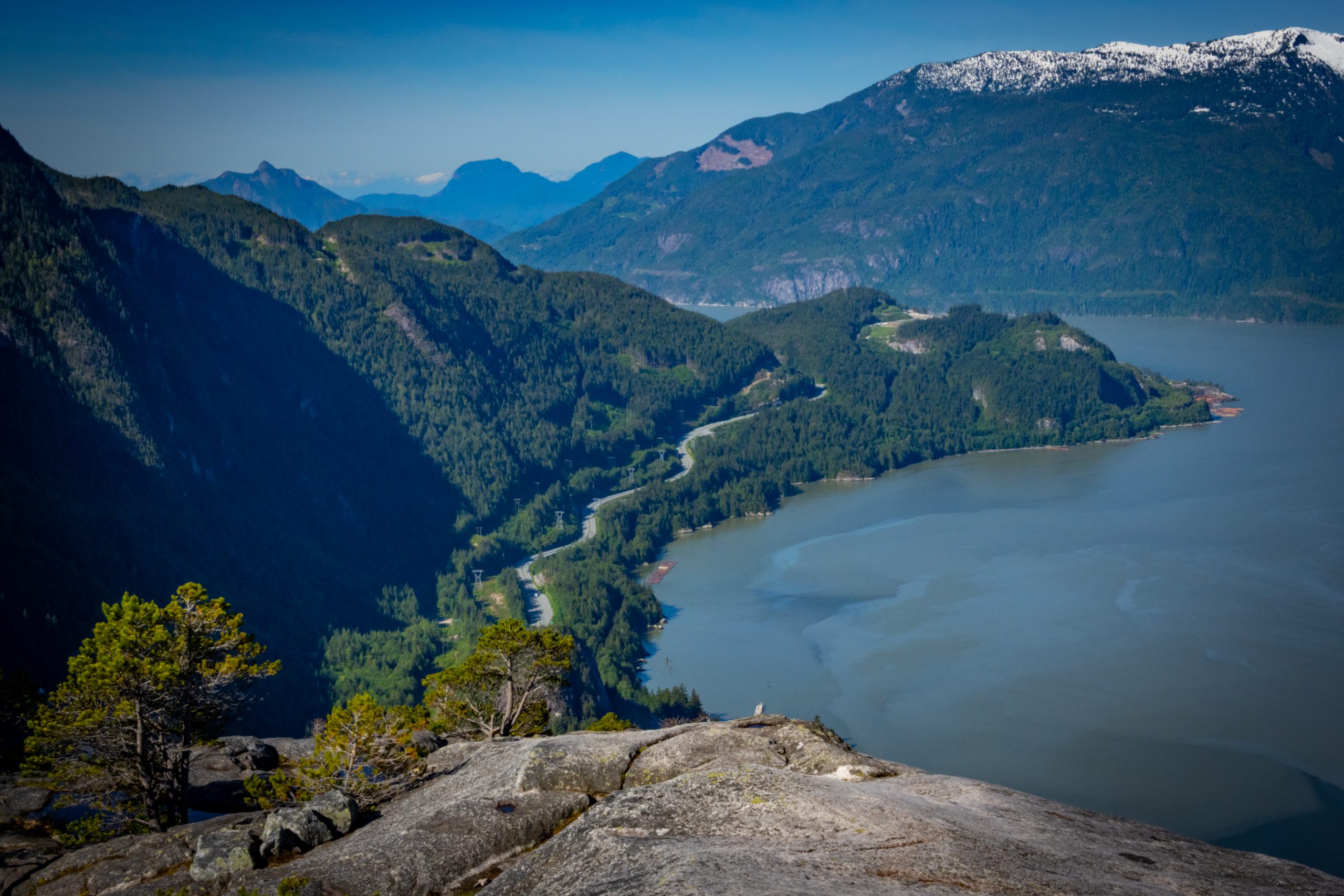
I feel pretty good after the steep 20-minute downhill back to the turn-off to The Chief’s second and third summit, but I can’t decide if I want to tackle the last two Chief summits and risk not being able to hike to the Summit Lodge, which sits behind and above the Chief and apparently offers some amazing vistas. I begin walking toward the second summit then turn on my heels and head back down the mountain.
About half a kilometre down the trail, I find the turn-off to the Sky to Summit Trail and begin the 7.5 kilometre hike, with 600 vertical metres of height gained. Various websites estimate the hike from here to the top is between 3 and 4 hours of strenuous hiking. Normally, when I read an estimated time to complete a trail, I knock a third of the time off, as I feel I can cover the distance faster than average. But not out here and not now, with the vertiginous terrain and my relative lack of fitness due to post-Covid symptoms.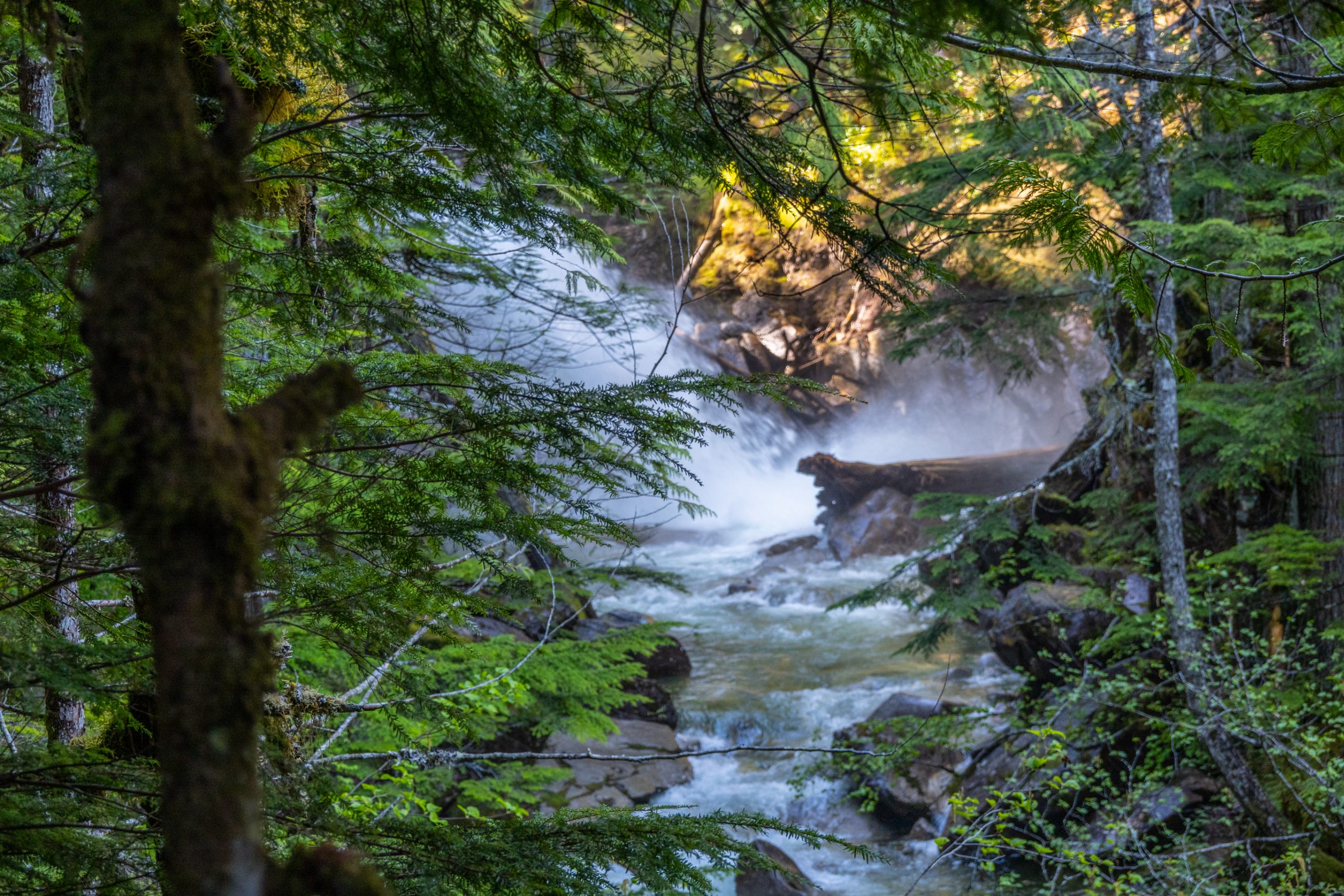
The trail includes scenic waterfalls, gnarly rock and tree root scrambling on all fours, and some more Batman-style rope and chain climbing. There are only a few moments during my heart-pounding sweat-stained ascent that I wonder if I’ve overcommitted. But there is a point in every journey, where it’s more efficient to keep pushing forward than it is to turn back. So onward it is.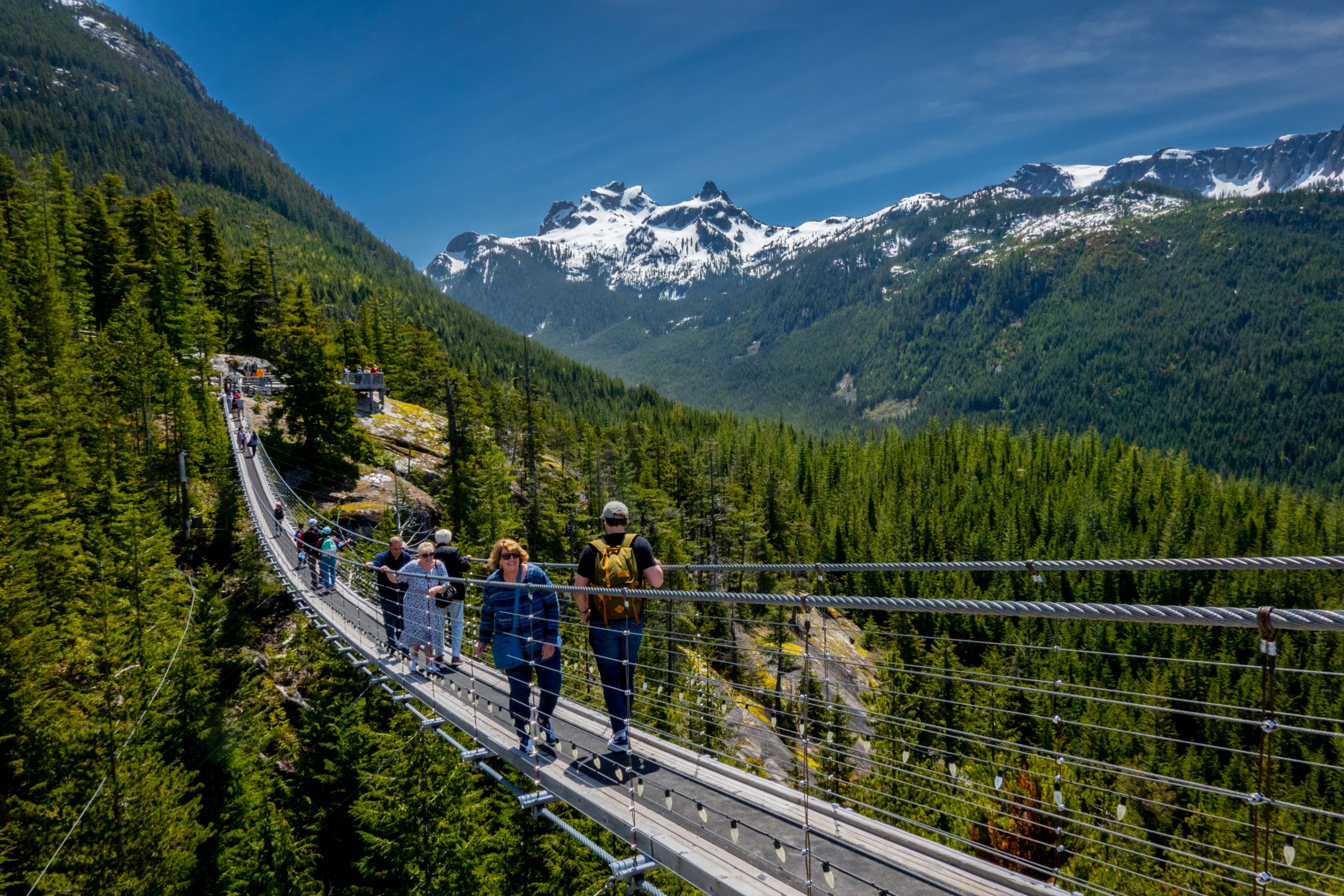
I arrive at the Summit Lodge before noon, and, as expected, it’s filled with visitors, who I suspect (based on a lack of sweat stains) have largely arrived by gondola. The paths up here are access-friendly and well graded for strollers, little kids, and those with mobility issues. I spend about an hour exploring these intertwining trails and checking out the various lookouts, with views out over Howe Sound, the Tantulus Range, and other snow-covered peaks as far as the eye can see. There is also a fantastic slope of granite looking south toward the multi-horned summit of Sky Pilot Mountain.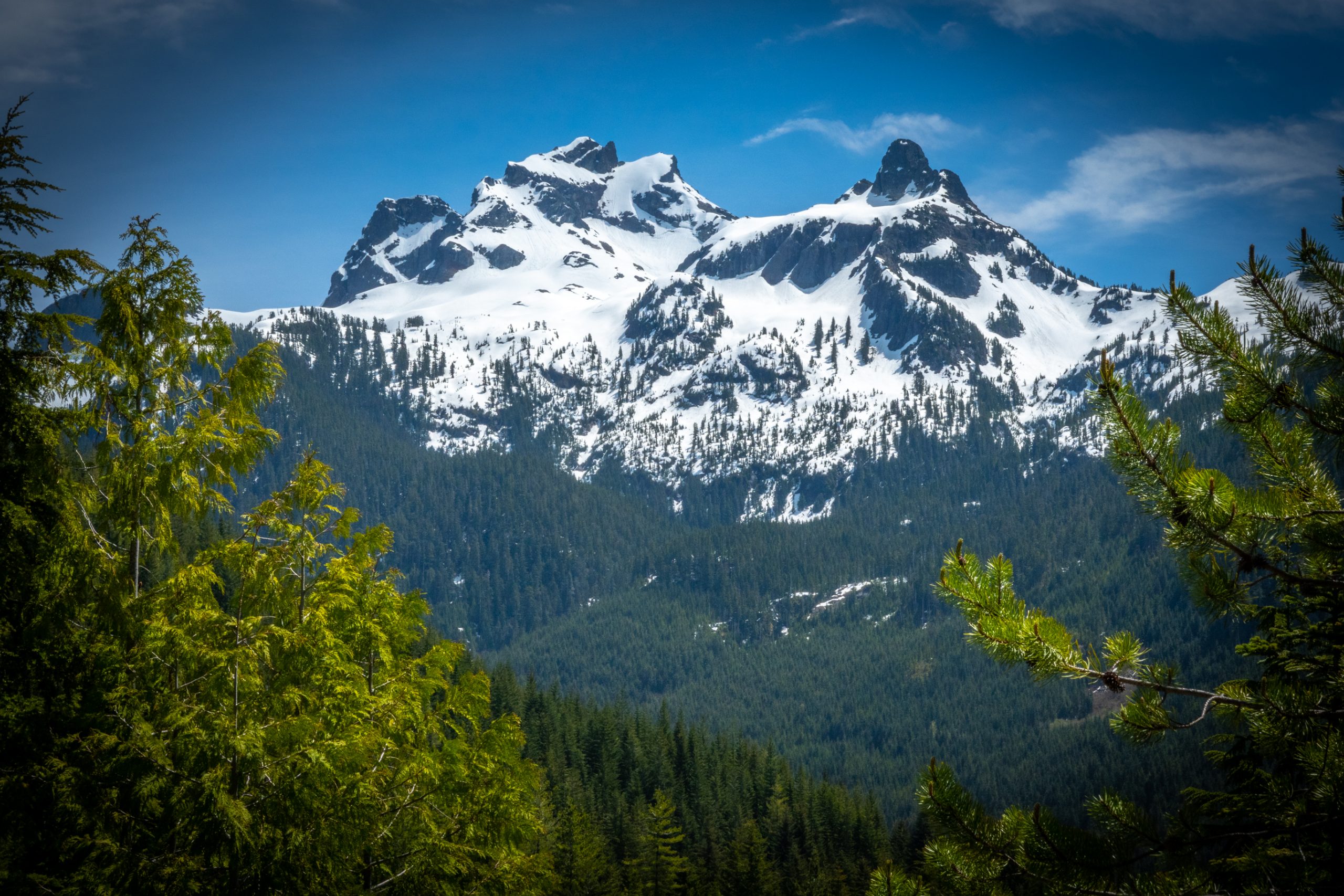
It’s on this slab that I decide to take off my shoes and bask in the sun. A small, impatient voice tells me to keep moving, that it’s a waste of time just to lie there being kissed by the sun. The other voice in my head – the chill one – asks what the rush is. To get back to my hotel room to download photos of beautiful places instead of being in that beautiful place? No, the voice of reason now insists, there are no pressing matters below, so I relax on that dome of sun-warmed granite for more than half an hour.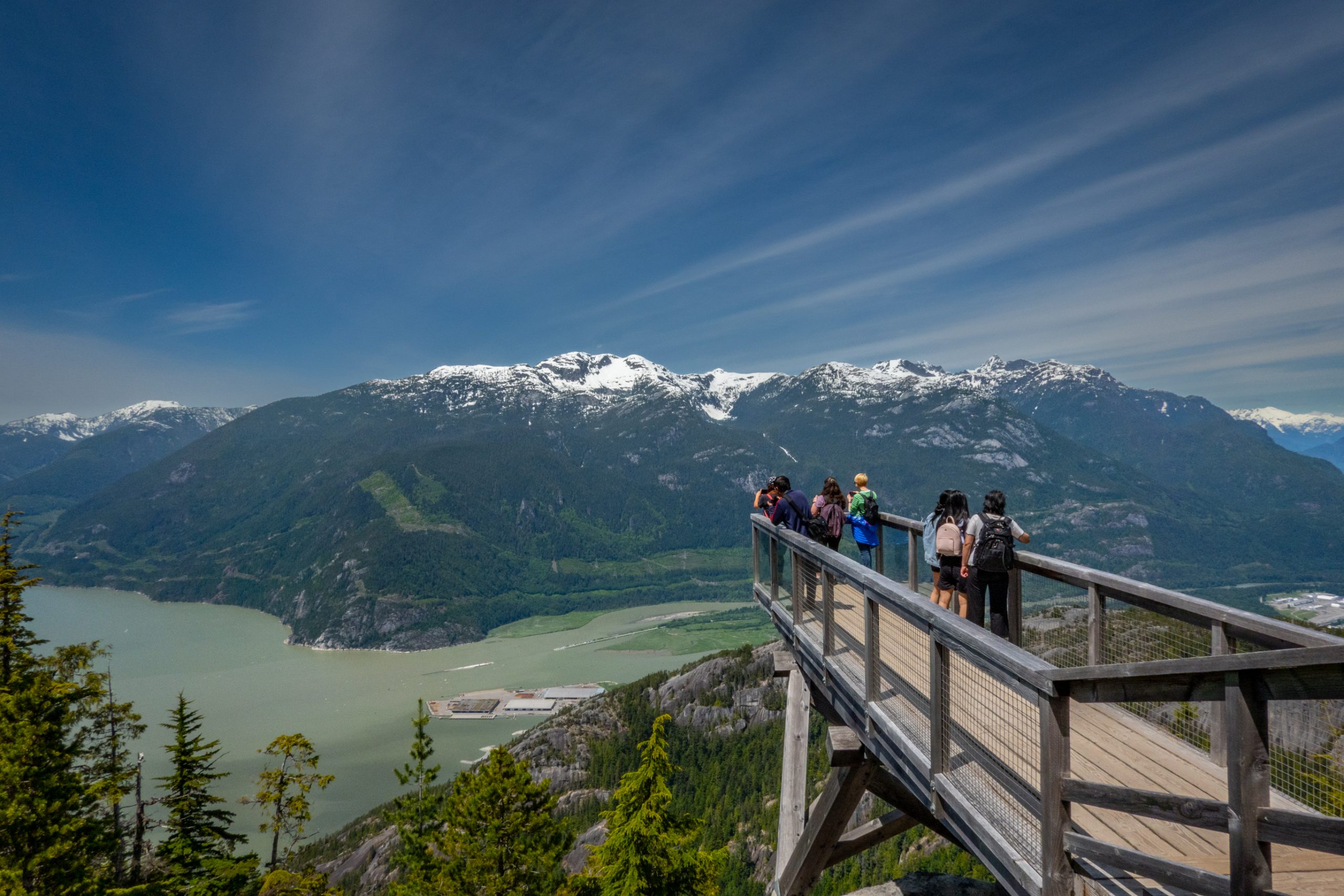
With a new weather system slowly setting in over the area, I finally peel myself from my granite nap and fork out $22 to take the gondola down the mountain. I begin the walk back to town, passing below the Chief’s many faces, beneath which lie countless boulders that have flaked off over countless years. This granitic exfoliation has been a windfall for climbers. I watch several groups of men and women with large rectangular crashmats strapped to their backs enter the forest below the Grand Wall. 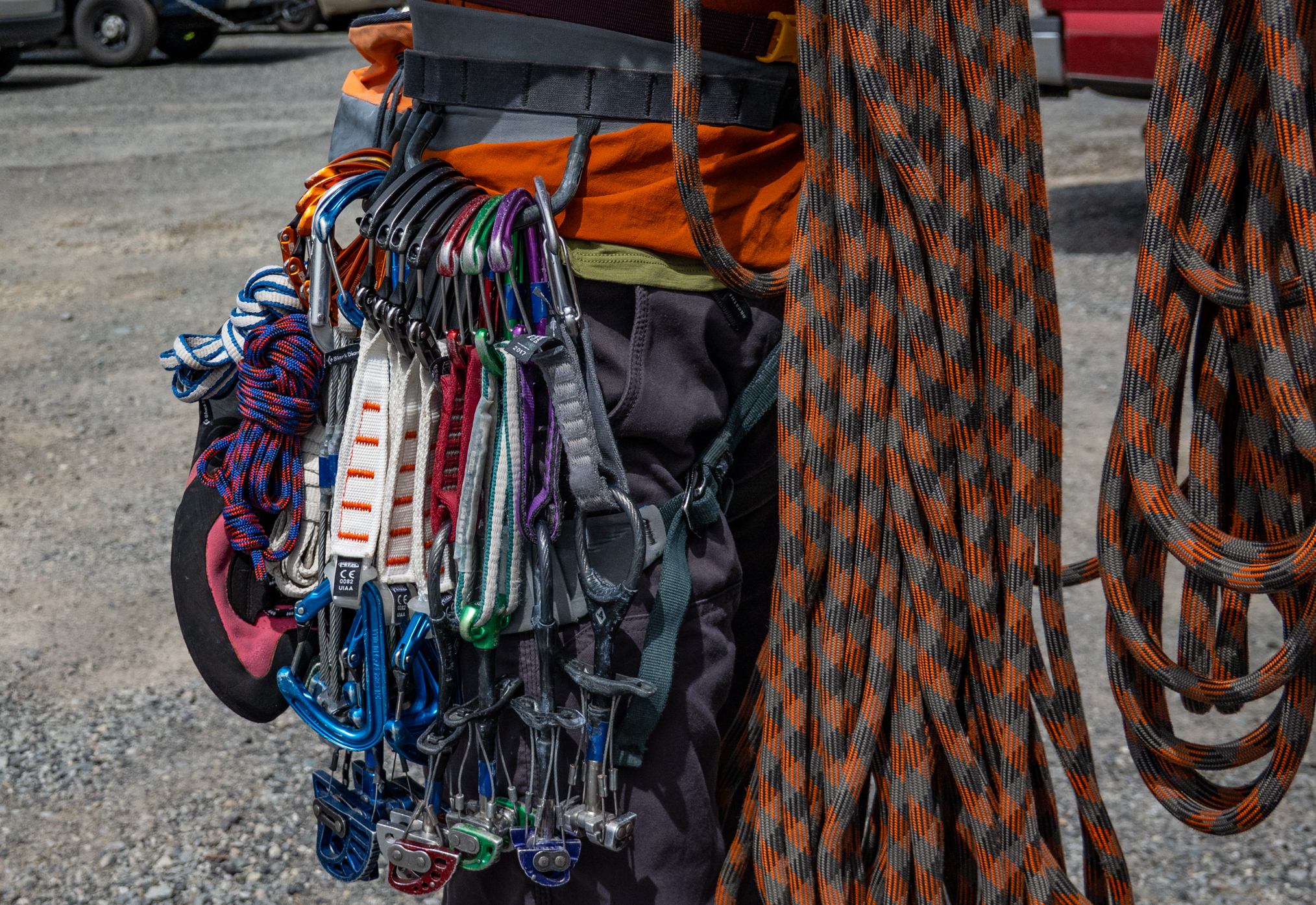
I poke my head into the woods to see what’s cooking. Beneath several boulders, small clusters of climbers have congregated, puzzling over various boulder problems. One group has a video crew documenting them, while another twosome quietly works away on an overhanging section of rock. No doubt, we are in world-class climbing territory (The Chief is sometimes called Yosemite North). I strangely feel like an intruder peeking in on a secret club that I don’t belong to, so I leave the forest and the climbers to puzzle away on the rock.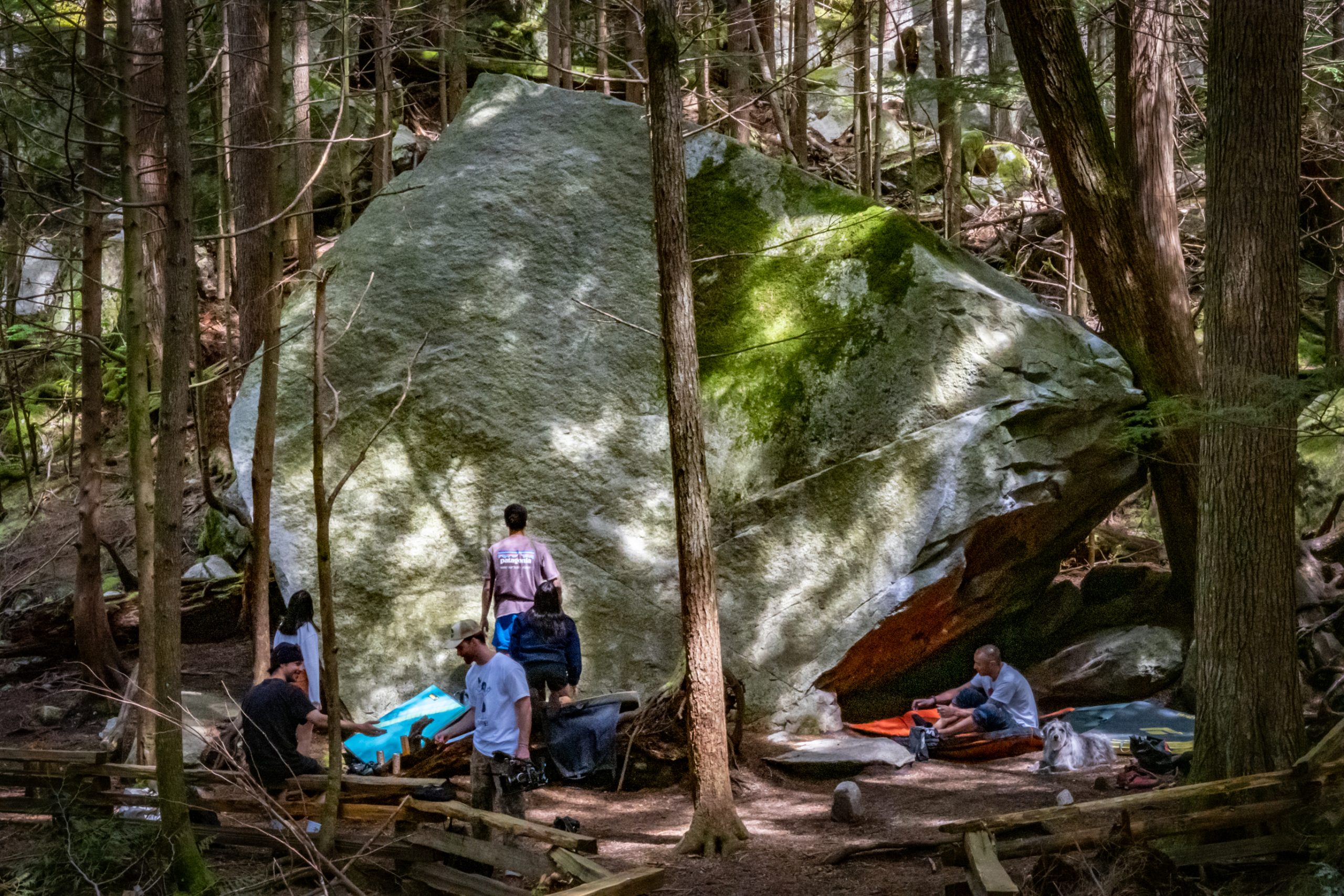
I make my way back to Squamish, where for the next 5 days I leisurely soak up my surroundings, read, nap, jot down notes for my novel, meet with old friends, and trail run up and around Smoke Bluffs Park, a kilometre from downtown. In many ways, the trip is uneventful (but never boring!). Afterall, I haven’t taken full advantage of all the possibilities available to me here — like river-rafting, SUP boarding, kite-surfing, cycling, and rock-climbing. But what I’ve been seeking, I have found: healing and a calm mind after two long years of a life-changing pandemic. This retreat has not only been restorative, it has inspired me to seek more balance at home — between life and work, between life online and offline (thanks for pointing the way Jimmy Martinello!).
Watch the video from the trip:
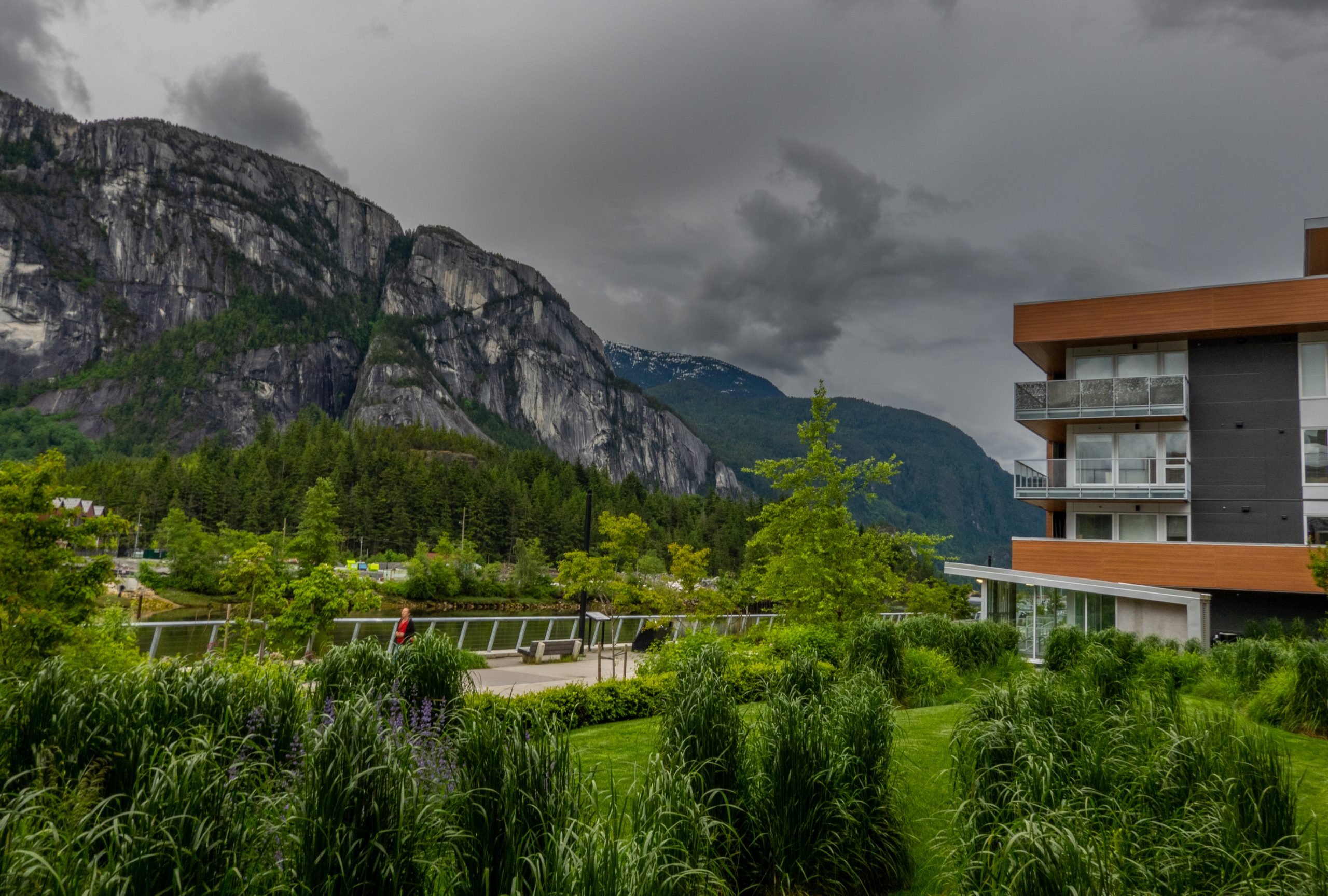
Leave a Reply
You must be logged in to post a comment.